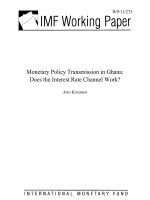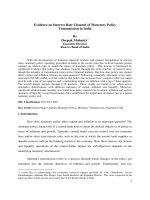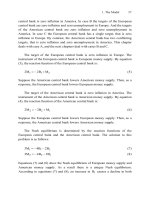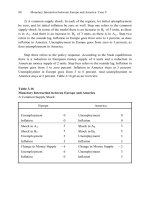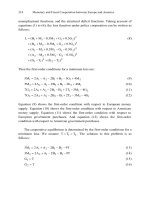Monetary policy strategies in the world economy carlberg_4 pptx
Bạn đang xem bản rút gọn của tài liệu. Xem và tải ngay bản đầy đủ của tài liệu tại đây (1.38 MB, 31 trang )
88
2) A common supply shock. In each of the regions, let initial unemployment
be zero, and let initial inflation be zero as well. Step one refers to the common
supply shock. In terms of the model there is an increase in
1
B of 3 units, as there
is in
1
A . And there is an increase in
2
B of 3 units, as there is in
2
A . Step two
refers to the outside lag. Inflation in Europe goes from zero to 3 percent, as does
inflation in America. Unemployment in Europe goes from zero to 3 percent, as
does unemployment in America.
Step three refers to the policy response. According to the Nash equilibrium
there is a reduction in European money supply of 4 units and a reduction in
American money supply of 2 units. Step four refers to the outside lag. Inflation in
Europe goes from 3 to zero percent. Inflation in America stays at 3 percent.
Unemployment in Europe goes from 3 to 6 percent. And unemployment in
America stays at 3 percent. Table 3.16 gives an overview.
Table 3.16
Monetary Interaction between Europe and America
A Common Supply Shock
Europe America
Unemployment 0 Unemployment 0
Inflation 0 Inflation 0
Shock in A
1
3
Shock in A
2
3
Shock in B
1
3
Shock in B
2
3
Unemployment 3 Unemployment 3
Inflation 3 Inflation 3
Change in Money Supply
− 4
Change in Money Supply
− 2
Unemployment 6 Unemployment 3
Inflation 0 Inflation 3
Monetary Interaction between Europe and America: Case C
89
First consider the effects on Europe. As a result, given a common supply
shock, monetary interaction produces zero inflation in Europe. However, as a
side effect, it raises unemployment there. Second consider the effects on
America. As a result, monetary interaction has no effect on inflation and
unemployment in America. The initial loss of each central bank is zero. The
common supply shock causes a loss to the European central bank of 9 units and a
loss to the American central bank of 18 units. Then monetary interaction reduces
the loss of the European central bank from 9 to zero units. On the other hand, it
keeps the loss of the American central bank at 18 units.
3) A common mixed shock. In each of the regions, let initial unemployment
be zero, and let initial inflation be zero as well. Step one refers to the common
mixed shock. In terms of the model there is an increase in
1
B of 6 units and an
increase in
2
B of equally 6 units. Step two refers to the outside lag. Inflation in
Europe goes from zero to 6 percent, as does inflation in America. Unemployment
in Europe stays at zero percent, as does unemployment in America.
Step three refers to the policy response. According to the Nash equilibrium
there is a reduction in European money supply of 10 units and a reduction in
American money supply of 8 units. Step four refers to the outside lag. Inflation in
Europe goes from 6 to zero percent. Inflation in America goes from 6 to 3
percent. Unemployment in Europe goes from zero to 6 percent. And
unemployment in America goes from zero to 3 percent. For a synopsis see Table
3.17.
First consider the effects on Europe. As a result, given a common mixed
shock, monetary interaction produces zero inflation in Europe. However, as a
side effect, it produces unemployment there. Second consider the effects on
America. As a result, monetary interaction lowers inflation in America. On the
other hand, it raises unemployment there. The initial loss of each central bank is
zero. The common mixed shock causes a loss to the European central bank of 36
units and a loss to the American central bank of equally 36 units. Then monetary
interaction reduces the loss of the European central bank from 36 to zero units.
Similarly, it reduces the loss of the American central bank from 36 to 18 units.
2. Some Numerical Examples
90
Table 3.17
Monetary Interaction between Europe and America
A Common Mixed Shock
Europe America
Unemployment 0 Unemployment 0
Inflation 0 Inflation 0
Shock in A
1
0
Shock in A
2
0
Shock in B
1
6
Shock in B
2
6
Unemployment 0 Unemployment 0
Inflation 6 Inflation 6
Change in Money Supply
− 10
Change in Money Supply
− 8
Unemployment 6 Unemployment 3
Inflation 0 Inflation 3
4) Another common mixed shock. In each of the regions, let initial
unemployment be zero, and let initial inflation be zero as well. Step one refers to
the common mixed shock. In terms of the model there is an increase in
1
A of 6
units and an increase in
2
A of equally 6 units. Step two refers to the outside lag.
Unemployment in Europe goes from zero to 6 percent, as does unemployment in
America. Inflation in Europe stays at zero percent, as does inflation in America.
Step three refers to the policy response. According to the Nash equilibrium
there is an increase in European money supply of 2 units and an increase in
American money supply of 4 units. Step four refers to the outside lag.
Unemployment in Europe stays at 6 percent. Unemployment in America goes
from 6 to 3 percent. Inflation in Europe stays at zero percent. And inflation in
America goes from zero to 3 percent. For an overview see Table 3.18.
First consider the effects on Europe. As a result, given another common
mixed shock, monetary interaction produces zero inflation in Europe. However,
as a side effect, it produces unemployment there. Second consider the effects on
Monetary Interaction between Europe and America: Case C
91
America. As a result, monetary interaction lowers unemployment in America. On
the other hand, it raises inflation there. The initial loss of each central bank is
zero. The common mixed shock causes a loss to the European central bank of
zero units and a loss to the American central bank of 36 units. Then monetary
interaction keeps the loss of the European central bank at zero units. And what is
more, it reduces the loss of the American central bank from 36 to 18 units.
Table 3.18
Monetary Interaction between Europe and America
Another Common Mixed Shock
Europe America
Unemployment 0 Unemployment 0
Inflation 0 Inflation 0
Shock in A
1
6
Shock in A
2
6
Shock in B
1
0
Shock in B
2
0
Unemployment 6 Unemployment 6
Inflation 0 Inflation 0
Change in Money Supply 2 Change in Money Supply 4
Unemployment 6 Unemployment 3
Inflation 0 Inflation 3
5) Summary. Given a common demand shock, monetary interaction produces
zero inflation and zero unemployment in each of the regions. Given a common
supply shock, monetary interaction produces zero inflation in Europe. And what
is more, monetary interaction has no effect on inflation and unemployment in
America. Given a common mixed shock, monetary interaction produces zero
inflation in Europe. And what is more, monetary interaction lowers inflation in
America. On the other hand, it raises unemployment there.
2. Some Numerical Examples
92
Chapter 4
Monetary Cooperation
between Europe and America: Case A
The model of unemployment and inflation can be characterized by a system
of four equations:
111 2
uAM0.5M=− + (1)
222 1
uAM0.5M=− + (2)
11 1 2
B M 0.5Mπ= + − (3)
22 2 1
BM0.5Mπ= + − (4)
As to policy targets there are three distinct cases. In case A the targets of
monetary cooperation are zero inflation in Europe and America. In case B the
targets of monetary cooperation are zero inflation and zero unemployment in
each of the regions. In case C the targets of monetary cooperation are zero
inflation in Europe, zero inflation in America, and zero unemployment in
America. This chapter deals with case A, and the next chapters deal with cases B
and C.
The policy makers are the European central bank and the American central
bank. The targets of monetary cooperation are zero inflation in Europe and
America. The instruments of monetary cooperation are European money supply
and American money supply. There are two targets and two instruments. We
assume that the European central bank and the American central bank agree on a
common loss function:
22
12
L =π +π
(5)
L is the loss caused by inflation in Europe and America. We assume equal
weights in the loss function. The specific target of monetary cooperation is to
minimize the loss, given the inflation functions in Europe and America. Taking
M. Carlberg, Monetary and Fiscal Strategies in the World Economy, 92
DOI 10.1007/978-3-642-10476-3_12, © Springer-Verlag Berlin Heidelberg 2010
93
account of equations (3) and (4), the loss function under monetary cooperation
can be written as follows:
22
11 2 2 2 1
L (B M 0.5M ) (B M 0.5M )=+− ++−
(6)
Then the first-order conditions for a minimum loss are:
121 2
5M 2B 4B 4M=−+ (7)
212 1
5M 2B 4B 4M=−+ (8)
Equation (7) shows the first-order condition with respect to European money
supply. And equation (8) shows the first-order condition with respect to
American money supply.
The cooperative equilibrium is determined by the first-order conditions for a
minimum loss. The solution to this problem is as follows:
112
3M 4B 2B=− − (9)
221
3M 4B 2B=− − (10)
Equations (9) and (10) show the cooperative equilibrium of European money
supply and American money supply. As a result there is a unique cooperative
equilibrium. An increase in
1
B causes a reduction in both European and
American money supply. Obviously, the cooperative equilibrium is identical to
the corresponding Nash equilibrium. That is to say, monetary cooperation case A
is equivalent to monetary interaction case A. For some numerical examples see
Chapter 1.
Monetary Cooperation between Europe and America: Case A
94
Chapter 5
Monetary Cooperation
between Europe and America: Case B
The model of unemployment and inflation can be represented by a system of
four equations:
111 2
uAM0.5M=− + (1)
222 1
uAM0.5M=− + (2)
11 1 2
B M 0.5Mπ= + − (3)
22 2 1
BM0.5Mπ= + − (4)
The policy makers are the European central bank and the American central
bank. The targets of monetary cooperation are zero inflation and zero
unemployment in each of the regions. The instruments of monetary cooperation
are European money supply and American money supply. There are four targets
but only two instruments, so what is needed is a loss function. We assume that
the European central bank and the American central bank agree on a common
loss function:
2222
1212
Luu=π +π + +
(5)
L is the loss caused by inflation and unemployment in each of the regions. We
assume equal weights in the loss function. The specific target of monetary
cooperation is to minimize the loss, given the inflation functions and the
unemployment functions. Taking account of equations (1), (2), (3) and (4), the
loss function under monetary cooperation can be written as follows:
22
11 2 2 2 1
L (B M 0.5M ) (B M 0.5M )=+− ++−
22
11 2 22 1
(A M 0.5M ) (A M 0.5M )+−+ + −+
(6)
M. Carlberg, Monetary and Fiscal Strategies in the World Economy, 94
DOI 10.1007/978-3-642-10476-3_13, © Springer-Verlag Berlin Heidelberg 2010
95
Then the first-order conditions for a minimum loss are:
11212 2
5M 2A A 2B B 4M=−−++ (7)
221211
5M 2A A 2B B 4M=−−++ (8)
Equation (7) shows the first-order condition with respect to European money
supply. And equation (8) shows the first-order condition with respect to
American money supply.
The cooperative equilibrium is determined by the first-order conditions for a
minimum loss. The solution to this problem is as follows:
11212
3M 2A A 2B B=+−− (9)
22121
3M 2A A 2B B=+−− (10)
Equations (9) and (10) show the cooperative equilibrium of European money
supply and American money supply. As a result there is a unique cooperative
equilibrium. An increase in
1
A causes an increase in both European and
American money supply. Obviously, the cooperative equilibrium is identical to
the corresponding Nash equilibrium. That is to say, monetary cooperation case B
is equivalent to monetary interaction case B. For some numerical examples see
Chapter 2.
Monetary Cooperation between Europe and America: Case B
96
Chapter 6
Monetary Cooperation
between Europe and America: Case C
The model of unemployment and inflation can be characterized by a system
of four equations:
111 2
uAM0.5M=− + (1)
222 1
uAM0.5M=− + (2)
11 1 2
B M 0.5Mπ= + − (3)
22 2 1
BM0.5Mπ= + − (4)
The policy makers are the European central bank and the American central
bank. The targets of monetary cooperation are zero inflation in Europe, zero
inflation in America, and zero unemployment in America. The instruments of
monetary cooperation are European money supply and American money supply.
There are three targets but only two instruments, so what is needed is a loss
function. We assume that the European central bank and the American central
bank agree on a common loss function:
222
122
L0.50.5u=π + π +
(5)
L is the loss caused by inflation in Europe, inflation in America, and
unemployment in America. We assume equal weights in the loss function. The
specific target of monetary cooperation is to minimize the loss, given the
inflation functions and the unemployment function. Taking account of equations
(2), (3) and (4), the loss function under monetary cooperation can be written as
follows:
M. Carlberg, Monetary and Fiscal Strategies in the World Economy, 96
DOI 10.1007/978-3-642-10476-3_14, © Springer-Verlag Berlin Heidelberg 2010
97
2
11 2
L(B M 0.5M)=+−
2
22 1
0.5(B M 0.5M )++−
2
22 1
0.5(A M 0.5M )+−+
(6)
Then the first-order conditions for a minimum loss are:
12122
5M A 4B B 4M=− − + + (7)
22121
5M 2A 2B 2B 4M=+−+ (8)
Equation (7) shows the first-order condition with respect to European money
supply. And equation (8) shows the first-order condition with respect to
American money supply.
The cooperative equilibrium is determined by the first-order conditions for a
minimum loss. The solution to this problem is as follows:
12 12
3M A 4B B=− − (9)
2212
3M 2A 2B 2B=−− (10)
Equations (9) and (10) show the cooperative equilibrium of European money
supply and American money supply. As a result there is a unique cooperative
equilibrium. Obviously, the cooperative equilibrium is identical to the
corresponding Nash equilibrium. That is to say, monetary cooperation case C is
equivalent to monetary interaction case C. For some numerical examples see
Chapter 3.
Monetary Cooperation between Europe and America: Case C
Part Four
Fiscal Policies
in Europe and America
Absence of a Deficit Target
101
Chapter 1
Fiscal Interaction
between Europe and America
1. The Model
The world economy consists of two monetary regions, say Europe and
America. The monetary regions are the same size and have the same behavioural
functions. An increase in European government purchases lowers European
unemployment. On the other hand, it raises European inflation. Correspondingly,
an increase in American government purchases lowers American unemployment.
On the other hand, it raises American inflation. An essential point is that fiscal
policy in Europe has spillover effects on America and vice versa. An increase in
European government purchases lowers American unemployment and raises
American inflation. Similarly, an increase in American government purchases
lowers European unemployment and raises European inflation.
The model of unemployment and inflation can be represented by a system of
four equations:
111 2
uAG0.5G=−− (1)
222 1
uAG0.5G=−− (2)
111 2
BG0.5Gπ= + + (3)
222 1
BG0.5Gπ= + + (4)
Here
1
u denotes the rate of unemployment in Europe,
2
u is the rate of
unemployment in America,
1
π is the rate of inflation in Europe,
2
π is the rate of
inflation in America,
1
G is European government purchases,
2
G is American
government purchases,
1
A is some other factors bearing on the rate of
unemployment in Europe,
2
A is some other factors bearing on the rate of
unemployment in America,
1
B is some other factors bearing on the rate of
inflation in Europe, and
2
B is some other factors bearing on the rate of inflation
M. Carlberg, Monetary and Fiscal Strategies in the World Economy, 101
DOI 10.1007/978-3-642-10476-3_15, © Springer-Verlag Berlin Heidelberg 2010
102
in America. The endogenous variables are the rate of unemployment in Europe,
the rate of unemployment in America, the rate of inflation in Europe, and the rate
of inflation in America.
According to equation (1), European unemployment is a positive function of
1
A , a negative function of European government purchases, and a negative
function of American government purchases. According to equation (2),
American unemployment is a positive function of
2
A , a negative function of
American government purchases, and a negative function of European
government purchases. According to equation (3), European inflation is a
positive function of
1
B , a positive function of European government purchases,
and a positive function of American government purchases. According to
equation (4), American inflation is a positive function of
2
B , a positive function
of American government purchases, and a positive function of European
government purchases.
Now consider the direct effects. According to the model, an increase in
European government purchases lowers European unemployment. On the other
hand, it raises European inflation. Correspondingly, an increase in American
government purchases lowers American unemployment. On the other hand, it
raises American inflation. Then consider the spillover effects. According to the
model, an increase in European government purchases lowers American
unemployment and raises American inflation. Similarly, an increase in American
government purchases lowers European unemployment and raises European
inflation.
According to the model, a unit increase in European government purchases
lowers European unemployment by 1 percentage point. On the other hand, it
raises European inflation by 1 percentage point. And what is more, a unit
increase in European government purchases lowers American unemployment by
0.5 percentage points and raises American inflation by 0.5 percentage points. For
instance, let European unemployment be 2 percent, and let European inflation be
2 percent as well. Further, let American unemployment be 2 percent, and let
American inflation be 2 percent as well. Now consider a unit increase in
European government purchases. Then European unemployment goes from 2 to
1 percent. On the other hand, European inflation goes from 2 to 3 percent. And
Fiscal Interaction between Europe and America
103
what is more, American unemployment goes from 2 to 1.5 percent, and
American inflation goes from 2 to 2.5 percent.
The target of the European government is zero unemployment in Europe.
The instrument of the European government is European government purchases.
By equation (1), the reaction function of the European government is:
112
2G 2A G=− (5)
Suppose the American government raises American government purchases.
Then, as a response, the European government lowers European government
purchases.
The target of the American government is zero unemployment in America.
The instrument of the American government is American government purchases.
By equation (2), the reaction function of the American government is:
221
2G 2A G=− (6)
Suppose the European government raises European government purchases. Then,
as a response, the American government lowers American government
purchases.
The Nash equilibrium is determined by the reaction functions of the
European government and the American government. The solution to this
problem is as follows:
112
3G 4A 2A=− (7)
221
3G 4A 2A=− (8)
Equations (7) and (8) show the Nash equilibrium of European government
purchases and American government purchases. As a result there is a unique
Nash equilibrium. According to equations (7) and (8), an increase in
1
A causes
an increase in European government purchases and a decline in American
government purchases. A unit increase in
1
A causes an increase in European
government purchases of 1.33 units and a decline in American government
1. The Model
104
purchases of 0.67 units. As a result, given a shock, fiscal interaction produces
zero unemployment in Europe and America.
2. Some Numerical Examples
For easy reference, the basic model is summarized here:
111 2
uAG0.5G=−− (1)
222 1
uAG0.5G=−− (2)
111 2
BG0.5Gπ= + + (3)
222 1
BG0.5Gπ= + + (4)
And the Nash equilibrium can be described by two equations:
112
3G 4A 2A=− (5)
221
3G 4A 2A=− (6)
It proves useful to study six distinct cases:
- a demand shock in Europe
- a supply shock in Europe
- a mixed shock in Europe
- another mixed shock in Europe
- a common demand shock
- a common supply shock.
1) A demand shock in Europe. In each of the regions, let initial
unemployment be zero, and let initial inflation be zero as well. Step one refers to
a decline in the demand for European goods. In terms of the model there is an
increase in
1
A of 3 units and a decline in
1
B of equally 3 units. Step two refers
Fiscal Interaction between Europe and America
105
to the outside lag. Unemployment in Europe goes from zero to 3 percent.
Unemployment in America stays at zero percent. Inflation in Europe goes from
zero to – 3 percent. And inflation in America stays at zero percent.
Step three refers to the policy response. According to the Nash equilibrium
there is an increase in European government purchases of 4 units and a reduction
in American government purchases of 2 units. Step four refers to the outside lag.
Unemployment in Europe goes from 3 to zero percent. Unemployment in
America stays at zero percent. Inflation in Europe goes from – 3 to zero percent.
And inflation in America stays at zero percent. Table 4.1 presents a synopsis.
Table 4.1
Fiscal Interaction between Europe and America
A Demand Shock in Europe
Europe America
Unemployment 0 Unemployment 0
Inflation 0 Inflation 0
Shock in A
1
3
Shock in B
1
− 3
Unemployment 3 Unemployment 0
Inflation
− 3
Inflation 0
Change in Govt Purchases 4 Change in Govt Purchases
− 2
Unemployment 0 Unemployment 0
Inflation 0 Inflation 0
As a result, given a demand shock in Europe, fiscal interaction produces zero
unemployment and zero inflation in each of the regions. The loss functions of the
European government and the American government are respectively:
2. Some Numerical Examples
106
2
11
Lu=
(7)
2
22
Lu=
(8)
The initial loss of the European government is zero, as is the initial loss of the
American government. The demand shock in Europe causes a loss to the
European government of 9 units and a loss to the American government of zero
units. Then fiscal interaction reduces the loss of the European government from 9
to zero units. And what is more, fiscal interaction keeps the loss of the American
government at zero units.
2) A supply shock in Europe. In each of the regions let initial unemployment
be zero, and let initial inflation be zero as well. Step one refers to the supply
shock in Europe. In terms of the model there is an increase in
1
B of 3 units and
an increase in
1
A of equally 3 units. Step two refers to the outside lag. Inflation
in Europe goes from zero to 3 percent. Inflation in America stays at zero percent.
Unemployment in Europe goes from zero to 3 percent. And unemployment in
America stays at zero percent.
Step three refers to the policy response. According to the Nash equilibrium
there is an increase in European government purchases of 4 units and a reduction
in American government purchases of 2 units. Step four refers to the outside lag.
Unemployment in Europe goes from 3 to zero percent. Unemployment in
America stays at zero percent. Inflation in Europe goes from 3 to 6 percent. And
inflation in America stays at zero percent. Table 4.2 gives an overview.
First consider the effects on Europe. As a result, given a supply shock in
Europe, fiscal interaction produces zero unemployment in Europe. However, as a
side effect, it raises inflation there. Second consider the effects on America. As a
result, fiscal interaction produces zero unemployment and zero inflation in
America. The initial loss of each government is zero. The supply shock in Europe
causes a loss to the European government of 9 units and a loss to the American
government of zero units. Then fiscal interaction reduces the loss of the
European government from 9 to zero units. And what is more, it keeps the loss of
the American government at zero units.
Fiscal Interaction between Europe and America
107
Table 4.2
Fiscal Interaction between Europe and America
A Supply Shock in Europe
Europe America
Unemployment 0 Unemployment 0
Inflation 0 Inflation 0
Shock in A
1
3
Shock in B
1
3
Unemployment 3 Unemployment 0
Inflation 3 Inflation 0
Change in Govt Purchases 4 Change in Govt Purchases
− 2
Unemployment 0 Unemployment 0
Inflation 6 Inflation 0
3) A mixed shock in Europe. In each of the regions, let initial unemployment
be zero, and let initial inflation be zero as well. Step one refers to the mixed
shock in Europe. In terms of the model there is an increase in
1
A of 6 units. Step
two refers to the outside lag. Unemployment in Europe goes from zero to 6
percent. Unemployment in America stays at zero percent. Inflation in Europe
stays at zero percent, as does inflation in America.
Step three refers to the policy response. According to the Nash equilibrium
there is an increase in European government purchases of 8 units and a reduction
in American government purchases of 4 units. Step four refers to the outside lag.
Unemployment in Europe goes from 6 to zero percent. Unemployment in
America stays at zero percent. Inflation in Europe goes from zero to 6 percent.
And inflation in America stays at zero percent. For a synopsis see Table 4.3.
First consider the effects on Europe. As a result, given a mixed shock in
Europe, fiscal interaction produces zero unemployment in Europe. However, as a
side effect, it produces inflation there. Second consider the effects on America.
2. Some Numerical Examples
108
As a result, fiscal interaction produces zero unemployment and zero inflation in
America. The initial loss of each government is zero. The mixed shock in Europe
causes a loss to the European government of 36 units and a loss to the American
government of zero units. Then fiscal interaction reduces the loss of the
European government from 36 to zero units. And what is more, it keeps the loss
of the American government at zero units.
Table 4.3
Fiscal Interaction between Europe and America
A Mixed Shock in Europe
Europe America
Unemployment 0 Unemployment 0
Inflation 0 Inflation 0
Shock in A
1
6
Shock in B
1
0
Unemployment 6 Unemployment 0
Inflation 0 Inflation 0
Change in Govt Purchases 8 Change in Govt Purchases
− 4
Unemployment 0 Unemployment 0
Inflation 6 Inflation 0
4) Another mixed shock in Europe. In each of the regions, let initial
unemployment be zero, and let initial inflation be zero as well. Step one refers to
the mixed shock in Europe. In terms of the model there is an increase in
1
B of 6
units. Step two refers to the outside lag. Inflation in Europe goes from zero to 6
percent. Inflation in America stays at zero percent. Unemployment in Europe
stays at zero percent, as does unemployment in America.
Step three refers to the policy response. According to the Nash equilibrium
there is no change in European government purchases, nor is there in American
Fiscal Interaction between Europe and America
109
government purchases. Step four refers to the outside lag. Inflation in Europe
stays at 6 percent. Inflation in America stays at zero percent. Unemployment in
Europe stays at zero percent, as does unemployment in America. For an
overview see Table 4.4.
First consider the effects on Europe. As a result, given another mixed shock
in Europe, fiscal interaction produces zero unemployment in Europe. However,
as a side effect, it produces inflation there. Second consider the effects on
America. As a result, fiscal interaction produces zero unemployment and zero
inflation in America. The mixed shock in Europe causes no loss to the European
government or American government.
Table 4.4
Fiscal Interaction between Europe and America
Another Mixed Shock in Europe
Europe America
Unemployment 0 Unemployment 0
Inflation 0 Inflation 0
Shock in A
1
0
Shock in B
1
6
Unemployment 0 Unemployment 0
Inflation 6 Inflation 0
Change in Govt Purchases 0 Change in Govt Purchases 0
Unemployment 0 Unemployment 0
Inflation 6 Inflation 0
5) A common demand shock. In each of the regions, let initial unemployment
be zero, and let initial inflation be zero as well. Step one refers to a decline in the
demand for European and American goods. In terms of the model there is an
increase in
1
A of 3 units, a decline in
1
B of 3 units, an increase in
2
A of 3 units,
2. Some Numerical Examples
110
and a decline in
2
B of 3 units. Step two refers to the outside lag. Unemployment
in Europe goes from zero to 3 percent, as does unemployment in America.
Inflation in Europe goes from zero to – 3 percent, as does inflation in America.
Step three refers to the policy response. According to the Nash equilibrium
there is an increase in European government purchases and American
government purchases of 2 units each. Step four refers to the outside lag.
Unemployment in Europe goes from 3 to zero percent, as does unemployment in
America. Inflation in Europe goes from – 3 to zero percent, as does inflation in
America. Table 4.5 presents a synopsis.
Table 4.5
Fiscal Interaction between Europe and America
A Common Demand Shock
Europe America
Unemployment 0 Unemployment 0
Inflation 0 Inflation 0
Shock in A
1
3
Shock in A
2
3
Shock in B
1
− 3
Shock in B
2
− 3
Unemployment 3 Unemployment 3
Inflation
− 3
Inflation
− 3
Change in Govt Purchases 2 Change in Govt Purchases 2
Unemployment 0 Unemployment 0
Inflation 0 Inflation 0
As a result, given a common demand shock, fiscal interaction produces zero
unemployment and zero inflation in each of the regions. The initial loss of each
government is zero. The common demand shock causes a loss to the European
government of 9 units and a loss to the American government of equally 9 units.
Then fiscal interaction reduces the loss of the European government from 9 to
Fiscal Interaction between Europe and America
111
zero units. Correspondingly, it reduces the loss of the American government
from 9 to zero units.
6) A common supply shock. In each of the regions, let initial unemployment
be zero, and let initial inflation be zero as well. Step one refers to the common
supply shock. In terms of the model there is an increase in
1
B of 3 units, as there
is in
1
A . And there is an increase in
2
B of 3 units, as there is in
2
A . Step two
refers to the outside lag. Inflation in Europe goes from zero to 3 percent, as does
inflation in America. Unemployment in Europe goes from zero to 3 percent, as
does unemployment in America.
Step three refers to the policy response. According to the Nash equilibrium
there is an increase in European government purchases and American
government purchases of 2 units each. Step four refers to the outside lag.
Unemployment in Europe goes from 3 to zero percent, as does unemployment in
America. Inflation in Europe goes from 3 to 6 percent, as does inflation in
America. Table 4.6 gives an overview.
As a result, given a common supply shock, fiscal interaction produces zero
unemployment in Europe and America. However, as a side effect, it raises
inflation there. The initial loss of each government is zero. The common supply
shock causes a loss to the European government of 9 units and a loss to the
American government of equally 9 units. Then fiscal interaction reduces the loss
of the European government from 9 to zero units. Correspondingly, it reduces the
loss of the American government from 9 to zero units.
7) Summary. Given a demand shock in Europe, fiscal interaction produces
zero unemployment and zero inflation in each of the regions. Given a supply
shock in Europe, fiscal interaction produces zero unemployment in Europe.
However, as a side effect, it raises inflation there. Given a mixed shock in
Europe, fiscal interaction produces zero unemployment in Europe. However, as a
side effect, it causes inflation there. Given a common demand shock, fiscal
interaction produces zero unemployment and zero inflation in each of the
regions. Given a common supply shock, fiscal interaction produces zero
unemployment in Europe and America. However, as a side effect, it raises
inflation there.
2. Some Numerical Examples
112
Table 4.6
Fiscal Interaction between Europe and America
A Common Supply Shock
Europe America
Unemployment 0 Unemployment 0
Inflation 0 Inflation 0
Shock in A
1
3
Shock in A
2
3
Shock in B
1
3
Shock in B
2
3
Unemployment 3 Unemployment 3
Inflation 3 Inflation 3
Change in Govt Purchases 2 Change in Govt Purchases 2
Unemployment 0 Unemployment 0
Inflation 6 Inflation 6
Fiscal Interaction between Europe and America
113
Chapter 2
Fiscal Cooperation
between Europe and America
The model of unemployment and inflation can be characterized by a system
of four equations:
111 2
uAG0.5G=−− (1)
222 1
uAG0.5G=−− (2)
111 2
BG0.5Gπ= + + (3)
222 1
BG0.5Gπ= + + (4)
The policy makers are the European government and the American
government. The targets of fiscal cooperation are zero unemployment in Europe
and America. The instruments of fiscal cooperation are European government
purchases and American government purchases. There are two targets and two
instruments. We assume that the European government and the American
government agree on a common loss function:
22
12
Lu u=+
(5)
L is the loss caused by unemployment in Europe and America. We assume equal
weights in the loss function. The specific target of fiscal cooperation is to
minimize the loss, given the unemployment functions in Europe and America.
Taking account of equations (1) and (2), the loss function under fiscal
cooperation can be written as follows:
22
11 2 2 2 1
L (A G 0.5G ) (A G 0.5G )=−− +−−
(6)
Then the first-order conditions for a minimum loss are:
1122
5G 4A 2A 4G=+− (7)
M. Carlberg, Monetary and Fiscal Strategies in the World Economy, 113
DOI 10.1007/978-3-642-10476-3_16, © Springer-Verlag Berlin Heidelberg 2010
114
2211
5G 4A 2A 4G=+− (8)
Equation (7) shows the first-order condition with respect to European
government purchases. And equation (8) shows the first-order condition with
respect to American government purchases.
The cooperative equilibrium is determined by the first-order conditions for a
minimum loss. The solution to this problem is as follows:
112
3G 4A 2A=− (9)
221
3G 4A 2A=− (10)
Equations (9) and (10) show the cooperative equilibrium of European
government purchases and American government purchases. As a result there is
a unique cooperative equilibrium. An increase in
1
A causes an increase in
European government purchases and a decline in American government
purchases. A unit increase in
1
A causes an increase in European government
purchases of 1.33 units and a decline in American government purchases of 0.67
units. Obviously, the cooperative equilibrium is identical to the corresponding
Nash equilibrium. That is to say, fiscal cooperation is equivalent to fiscal
interaction. For some numerical examples see Chapter 1.
Fiscal Cooperation between Europe and America



